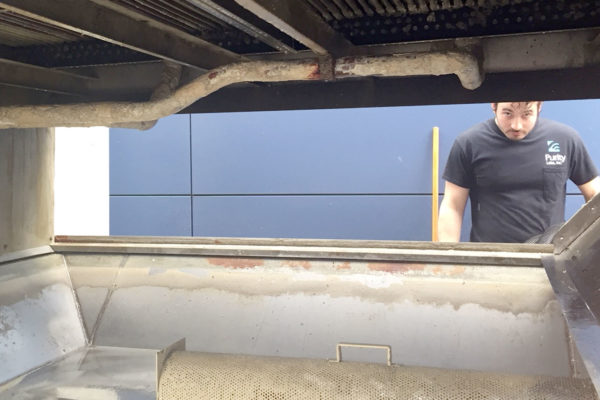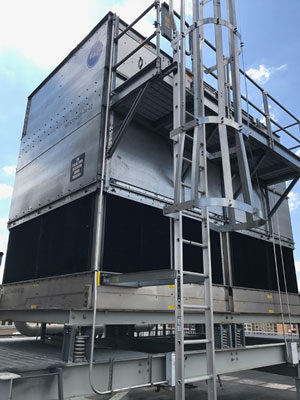Addressing Legionella
What is Legionella?
Legionella is the waterborne bacteria which causes Legionnaires’ disease, a type of pneumonia. People are exposed to Legionella when they breathe in mist (small droplets of water in the air) containing the bacteria. Adults over the age of 50 and people with weak immune systems, chronic lung disease, or heavy tobacco use are most at risk.
 Evaporative condensers, spray coolers and cooling towers are in fact air scrubbers that create gardens for waterborne problems, so any cooling tower is a possible breeding ground for Legionella and Legionnaires Disease. Additional risk considerations for Legionella include DX condenser coil/air cooled chiller misting devices, humidification system/spray trees and foggers.
Evaporative condensers, spray coolers and cooling towers are in fact air scrubbers that create gardens for waterborne problems, so any cooling tower is a possible breeding ground for Legionella and Legionnaires Disease. Additional risk considerations for Legionella include DX condenser coil/air cooled chiller misting devices, humidification system/spray trees and foggers.
A cooling tower is simply a heat exchanger that contains water and is used to remove excess heat from some buildings as part of their air conditioning, ventilation, and/or heating systems or as part of manufacturing processes. When the water contacts the air, some of the water evaporates, creating a cooling action thru evaporative cooling. This cools the water to extract waste heat into the atmosphere.
Cooling Towers Concentrate Contaminants
The air drawn through a cooling tower inevitably contains particles of dust, soil, soot, organic debris and numerous other materials. Because water is evaporating, these particles become concentrated in the water.
In addition to the air, the cooling tower system itself produces particles including corrosion products, mineral precipitates (e.g. iron oxides, hardness salts), microbiological colonies and aggregates of organic chemicals. Dissolved and particulate materials leaking from the process side of heat exchange equipment causes contamination. Contamination adds to the process by precipitating insoluble chemical products, providing nutrients for accelerated biological growth and accelerating corrosion and the formation of corrosion products.
Surfaces anomalies, scale, dirt loading and debris accumulations provide an ideal habitat for lethal waterborne pathogens. The particulates in cooling water, when bound together by precipitation of scale-forming minerals, result in increased volume of scale and a thicker scale layer. These layers decrease heat transfer efficiency, reduce flow rate across heat exchange surfaces and encourage corrosion, resulting in additional fouling. As expected, slower flow allows more particles to settle, amplifying the problem and further reducing efficiency. Purity Labs has also partnered with filtration experts Advance Filtration for cooling towers where a combination of chemical cleaning and filtration are called for.
In short, warm water mixed with nutrients is an ideal growing area for bacteria including legionella. Proper cooling tower maintenance allows for safe and efficient operation.

Legionnaires Disease and Cooling Towers in New York City
Building owners and property managers must register cooling towers, fluid coolers and evaporative condensers with the City of New York. If you have any of this equipment, you must register through the Department of Buildings at Cooling Tower Registration in compliance with Local Law 77 of 2015, which was made effective August 18th, 2015. (http://www1.nyc.gov/site/doh/health/health-topics/cooling- owers.page).
Commissioner’s Order
In 2015, the New York City Health Commissioner issued an order to all owners of buildings with cooling towers. This was in response to the Legionnaires’ Disease Outbreak in the South Bronx. Several cooling towers in the affected neighborhoods tested positive for legionella. To clarify, the outbreak has not affected the City’s drinking or bathing water; it is safe for building residents to drink and bathe with tap water. Also, home air conditioning units and air conditioned environments are also safe. More details at http://www1.nyc.gov/site/doh/health/health-topics/cooling- towers.page.
Also, building owners must file an annual certification (each year) that all cooling equipment was inspected, tested, cleaned and disinfected in accordance with the Maintenance Program and Plan (MPP)
Become NYC compliant around Legionnaires Disease
No manual did (or does) exist that building owner and cooling tower operators could go by.
In order to help building owners, Purity Labs understands the cooling tower laws and where building were out of compliance. As a result of our work and research, we have worked with numerous building owners to get their cooling towers into compliance.
Purity Labs not only helps you with chemically and physically cleaning and inspecting cooling towers to prevent Legionnaires Disease. In addition, Purity Labs can help with submitting and uploading compliance information and legionella testing and province certifications to the NYC Cooling Tower Registration Portal.
In Additions, Purity Labs’ work meets or exceeds standards put forth by ANSI/ASHRAE 188-2018 – Legionellosis: Risk Management for Building Water Systems.
Also Purity Labs can liaison between parties to find solutions to bring cooling towers into compliance and to maintain compliance. These parties can include hvac or mechanical and cooling tower manufacturers.
Additional Legionnaires Disease Prevention Links
- New York State Regulations and Registration:
www.health.ny.gov/press/releases/2016/2016-07-19_legionella_regulations_in_effect.htm
- New York State Department of Health Legionellosis Links
https://www.health.ny.gov/diseases/communicable/legionellosis/
